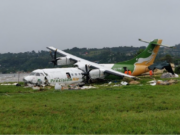
NAV CANADA has begun a project to utilize state-of-the-art weather forecasting technologies — including a new tool that analyzes weather and operational constraints to predict airport capacity — to better manage terminals and airspace.
“Our biggest challenge to predictability is weather,” says Blake Cushnie, program director, Service Delivery, NAV CANADA. “Our weather issues include winter storms, crosswinds, and thunderstorms in the terminal area. We want to get better knowledge on the timing and intensity of the weather, and translate that into the [potential] impact on operations. If it can be more predictable, we can better manage the impact.”
To achieve those goals, NAV CANADA is partnering with the MIT Lincoln Laboratory, an independent, federally funded research and development center located in Lexington, Massachusetts, U.S., and managed by the Massachusetts Institute of Technology.
Dr. Tom G. Reynolds, leader of the lab’s Air Traffic Control Systems Group, says the lab has “been working in the air traffic control domain for over 50 years to help develop advanced technologies to address safety and efficiency challenges.”
NAV CANADA said in a 2022 explanation of the project that the first phase “will entail bringing together various weather models to gain a more complete and accurate picture of weather impacts. The solutions will apply sophisticated algorithms to the data that generates these pictures to predict capacities at various key points in the aviation system.”
Those capacities will be compared to traffic demand expected at the same points “up to 12 hours into the future,” NAV CANADA said. “This information will result in the ability to make objective recommendations on potential best courses of planning actions. All of this will be shared in real time among stakeholders, including NAV CANADA Operations, Traffic Management Unit, airlines and airport authorities, who will then work together to make final decisions to minimize imbalances in capacity and demand.”
So far, Lincoln Laboratory has released several prototype technologies for the project, including the Airport Capacity Evaluation and Prediction Tool (ACEPT), which “looks at airport capacity for incoming flights,” Cushnie says. The tool is being developed specifically for NAV CANADA, but could be adapted for airports in other countries.
ACEPT predicts airport capacity for eight hours into the future, accounting for weather and operational constraints and identifying any periods when flight demand might exceed airport capacity. It allows for predicted weather situations, such as low visibility or strong winds, which can cause delays. If these situations are forecast correctly, delays can be planned for in advance, thus lessening the impact on air traffic.
Another technology being developed is designed to assess weather impacts in the terminal area. Cushnie says, “The Terminal Capacity Evaluation and Prediction Tool (TCEPT) predicts up to six hours in advance of where we’re going to get convective activity in the terminal area and [potential] impacts on terminal airspace capacity. We can reroute aircraft to avoid [the convective activity] and help maintain capacity.”
Both the ACEPT and the TCEPT prototypes are being deployed at Toronto Pearson International Airport, the largest airport in the Canadian system . Reynolds says, “There have now been multiple releases of ACEPT and TCEPT. It is accessible to approved users (which currently include NAV CANADA, airlines and other stakeholders) via an Internet application, which allows for easy access and rapid … development of refined capabilities as we get user feedback.”
Cushnie adds, “Both prototypes are still in a validation phase in our Toronto operation. Early signs are fairly encouraging to date.” Full deployment is expected later this year.
To complement these airport and terminal area technologies, Lincoln Laboratory has developed the Enroute Capacity Evaluation and Prediction Tool (ECEPT), which will “identify weather impacts [on] higher altitude airspace so the most efficient routes can be followed given the weather, traffic and downstream terminal and airport capacity impacts.” Reynolds says, “The first release of ECEPT occurred recently [among] a subset of users to help refine the concept of operations for this en route weather impact technology.”
Another technology previously developed by Lincoln Laboratory that holds promise for Canadian aviation weather awareness is called “synthetic weather radar.” Reynolds says that the synthetic weather radar machine learning technologies “create weather radar-like imagery in areas where actual weather radars do not have coverage. This gives aviation users in these regions weather situational awareness that they are used to interpreting. These technologies are being tailored to Canadian operational needs in the Canadian Aviation Weather System (CAWS), which will include aviation weather information at high latitude regions and the North Atlantic and Pacific oceanic regions where NAV CANADA handles traffic.”
Cushnie adds that the synthetic weather radar information “will be especially useful in northern Canada, where there are few radar sites. If we can accurately predict when and where weather will hit, we can manage our operations more efficiently.”
Reynolds says that the first release of CAWS is planned for later this year, and will “provide Canadian-optimized aviation weather products, including storm location, intensity and height, built on our U.S. aviation weather technologies.”
The ultimate plan is for all these prototype technologies to be integrated for managing demand and capacity imbalances in the key parts of Canadian aviation operations, including at major airports and in the surrounding terminal and en route airspace. A major part of NAV CANADA’s modernization program is incorporating trajectory based operations (TBO),which will require system-wide assessment of capacities. Cushnie says, “TBO will need to have an accurate weather component to be successful. This project is one of the building blocks of TBO.”
He says NAV CANADA will continue working with Lincoln Laboratory to develop a suite of products for TBO.
Image: © lsannes | iStockphoto
Edward Brotak, Ph.D., retired in 2007 after 25 years as a professor and program director in the Department of Atmospheric Sciences at the University of North Carolina, Asheville.



